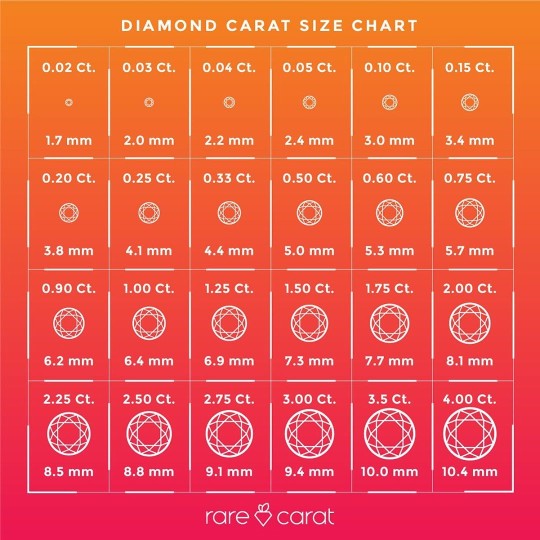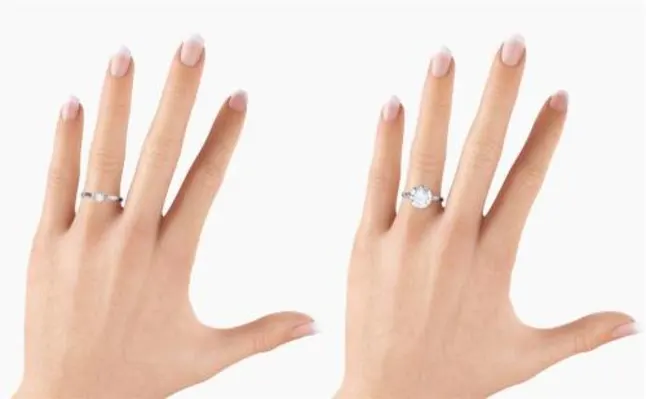What is Diamond Carat Weight? | 4C's Education
A comprehensive guide to the art and science of diamond carat
- Carat measures a diamond's weight, not size.
- Higher carat increases price exponentially.
- Visual size depends on cut and shape.
- Balance carat with cut for best look.
- Rare Carat has some of the most competitive prices on the internet, from 0.2ct to 30ct.
Fast Facts on Diamond Carat
- Carat refers to diamond weight and not to diamond size.
- "Buying shy" of a round carat weight number can save you money on a stone with a negligible visual size difference.
- Two diamonds of equal carat weight can appear as different sizes due to cut grade.
Weighing in on Carat
Meet Dave.

Dave owns a small diamond cutting and polishing business. One day he finds a 2.50 carat rough diamond on his desk. He examines the loose diamond, and spots an unsightly crystal inclusion. Dave has two choices here; the first option is to cut the diamond down enough that the inclusion disappears, yielding a stone of .90 carats, with a diamond clarity of VS2, and an ‘excellent’ diamond cut grade. He can make $3,700 off this stone.
His second option is to keep the inclusion and yield a 1.10 carat stone with a clarity grade of SI2, and a ‘very good’ cut. He can get $5,600 for this stone. Dave is no dope and recognizes that bigger is better, especially when it comes to profits. He cuts the diamond as a 1.10 carat stone, in the hopes of making almost $2,000 more than he would if he had cut it just a little bit smaller.
Dave’s choice is not an uncommon one within the diamond industry. The truth is that about 90% of diamonds are cut to maximize carat weight over any of the other ‘C’s. And with a yield of between 30% - 40% from rough to polished diamonds, it is understandable that people like Dave are trying to salvage as much of the stone as they can.
However, this emphasis on the carat weight of the stone means that the other aspects of it can look less important to potential buyers, even if the difference in size is negligible. If we take a look at this weight vs size chart for example, we will see very quickly that the difference between a .90 carat and 1.10 carat stone is almost indistinguishable;
Diamond Carat Size

In order to determine how big a stone will look in reality, you need to be aware of the stone’s proportions in relation to the weight. For example, using the chart above as a guide, we can see that a well-cut 1 carat stone will be approximately 6.4mm wide, while a .50 carat stone will be about 5.2mm. A whole half a carat difference in weight only equates to a 1.2mm difference in diameter!
Furthermore, just because a diamond is heavier does not always mean it is larger. Because the cut of Dave’s 1.10 carat stone is graded ‘very good’ for example, it’s likely the diamond is actually cut rather deep - meaning that tiny bit of extra carat weight is sitting not-so-prettily on the underside of the diamond where it is of zero value to anyone, except maybe Dave.
Meet Maria.

Maria is not smiling because she is a model that has been hired specifically to take this photo that I have randomly found online. Nope. She’s smiling because she just kicked her no-good boyfriend to the curb (Bye Felicia), and has decided to reward herself with a 1 carat diamond ring. Smart move, Maria.
Having painstakingly conducted her research on the internet (all while drinking that cheeky glass of cabernet), she has decided that a 1 carat, G color, SI1 clarity diamond with an excellent cut is exactly what she wants. Entering this information into the Rare Carat diamond search engine, she is surprised to find that a 1.10 carat meeting her requirements is a whopping $2,000 more expensive than a .90 carat of the exact same specifications. Let’s see what’s going on here.
The price discrepancy could simply be based upon the notion of rarity. This is because larger diamonds are harder to come by, and so as the carat weight increases the total price and the price-per-carat increases also:
Diamond Price Per Carat

To understand the exponential increase in price, let’s use a different example - one of my very favorite things: television. A 50-inch TV is twice the size of a 25-inch TV. However, it will not simply cost twice the price of the 25-inch TV. In fact, typically it will be almost three times the price, as it’s widely considered to be a much better product.
Diamonds are priced much in the same way, except instead of being priced by the inch they are priced by the carat. This means that the price-per-carat of a 1 carat diamond is higher than the price-per-carat of a .99 carat diamond. A tiny 1% increase in weight will mean a 15-20% jump in the price-per-carat, because you are moving up into the next category of weight. It must be noted that these price jumps happen around the .50 carat, .75 carat, .90 carat, 1 carat, 1.50 carat, and 2.00 carat marks, and are known as ‘magic sizes’ due to the sudden magic increase in price.
"This means that the price-per-carat of a 1 carat diamond is higher than the price-per-carat of a .99 carat diamond."
If this is the case, why then do people still opt for 1.10 carat stones instead of .90 carat stones? Well often the weight is symbolic, and people simply prefer the idea of having a full 1 carat (or slightly above) rather than the ‘just shy of’ diamonds around the .90 carat range.
This mentality leads to a higher demand for these sized diamonds, which in turn drives diamond cutters like Dave to try to push that weight over the ‘magic’ 1 carat mark - even if it means sacrificing on the cut of the diamond (like the mediocre 1.10 carat diamond he was peddling, sorry Dave). Meanwhile Maria - part-time wine model, full-time diamond slayer - has rightly decided to focus on those under-sized diamonds just below that magic 1 carat cutoff point, as they represent a better deal for her money in terms of both size and price.
Smart move, Maria. Smart move.
How much does a carat weigh?
Is a carat a weight or a size?
What is bigger ½ carat or 1/3 carat?
Does carat weight determine size?
How do you figure out carat weight?
Whats the best cut grade? Rare Carat Ideal! Check it out here
Looking for a deal? Check out all of our promos here
Promotions
Only one promotion or discount can be applied per order. Multiple promotions, discounts, or coupon codes cannot be combined or used together on a single purchase.

